13 Oct
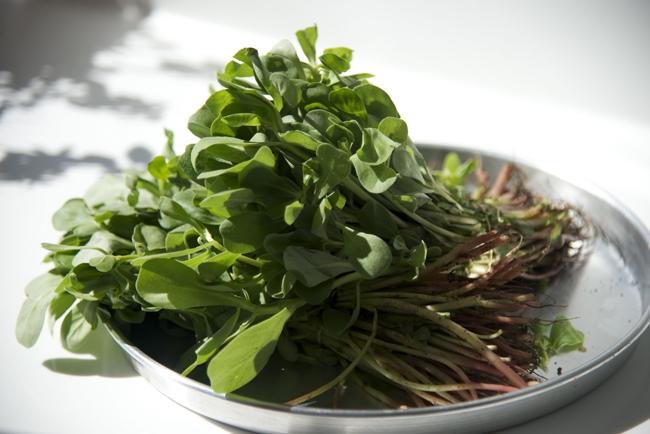 Until I started researching Mediterranean Street Food, I only knew fatayer (Lebanese triangular savoury pastries) as dainty little triangles, made at home by my mother and grandmother who were uncanny in how perfectly they shaped them and how well they sealed them so that none of the juice from the filling trickled out to spoil the look of the golden triangles. I also ate fatayer in restaurants of course. They were a little less dainty and a little less sour and with more crust than filling. But somehow I had never had them from a bakery. Perhaps because my mother sent out toppings for manaqish to the bakery for the baker to make our manaqish but she always made the fatayer at home. Things change naturally and my mother is no longer so young and now has her fatayer made by Emile, our local baker whose dough is just amazing. Of course, his fatayer are not dainty — unless it is a special order bakers make large fatayer for people to have as a snack or as a quick lunch on the go — but they are just as good as my mother’s and when I saw the fresh baqleh (purslane) at the greengrocer, I bought some and asked my mother to make the filling to take to Emile for him to make the fatayer.
Until I started researching Mediterranean Street Food, I only knew fatayer (Lebanese triangular savoury pastries) as dainty little triangles, made at home by my mother and grandmother who were uncanny in how perfectly they shaped them and how well they sealed them so that none of the juice from the filling trickled out to spoil the look of the golden triangles. I also ate fatayer in restaurants of course. They were a little less dainty and a little less sour and with more crust than filling. But somehow I had never had them from a bakery. Perhaps because my mother sent out toppings for manaqish to the bakery for the baker to make our manaqish but she always made the fatayer at home. Things change naturally and my mother is no longer so young and now has her fatayer made by Emile, our local baker whose dough is just amazing. Of course, his fatayer are not dainty — unless it is a special order bakers make large fatayer for people to have as a snack or as a quick lunch on the go — but they are just as good as my mother’s and when I saw the fresh baqleh (purslane) at the greengrocer, I bought some and asked my mother to make the filling to take to Emile for him to make the fatayer.
11 Oct

Just back from visiting my mother in Lebanon and because I hadn’t been for nearly two years, it was a rather nostalgic visit. I did things that I used to do when I lived there like going to the bakery to make manaqish for breakfast. It wasn’t any of the bakeries of my youth in west Beirut because my mother now lives in Balluneh in the mountains but I love Emile, her new baker, just as much as I loved our bakers in Hamra even if Emile doesn’t use firewood. His dough is wonderful though and people bring their own topping or filling (a very common practice in Lebanon) for him and his worker to shape and bake manaqish, fatayer and lahm bil-ajine.
4 Jul
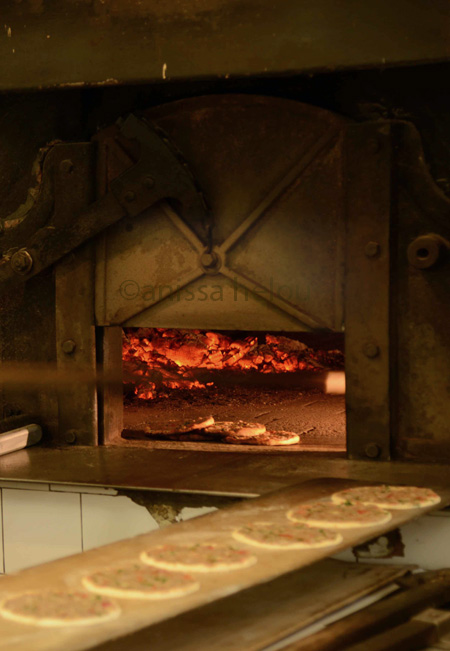
There are between 7 and 10 million Lebanese and Syrians in Brazil. And about 4 million of them are in Sao Paolo alone. As a result, Lebanese food is very familiar to Brazilians and specialities like sfiha (a term that covers both manaqish and fatayer) and kibbe have become part of the national culinary repertoire. And of course there are Lebanese restaurants galore. Some are good and some not so. I have now tried three and each is good in its own way even if they serve a different cuisine from the one I was brought up with. I guess it is because they have been in Brazil for several generations; and despite having preserved their culinary repertoire, serving unusual dishes like shish barak which is not normally found on restaurant menus, they have adapted and changed them slightly. A few days ago, I was taken by adorable Luiz Henrique Ligabue to Casa Garabed which loved, particularly the fact that it is in the garage and one bedroom of the owner’s home giving the restaurant a rather unusual feel: part bistrot and part home dining.
10 Dec
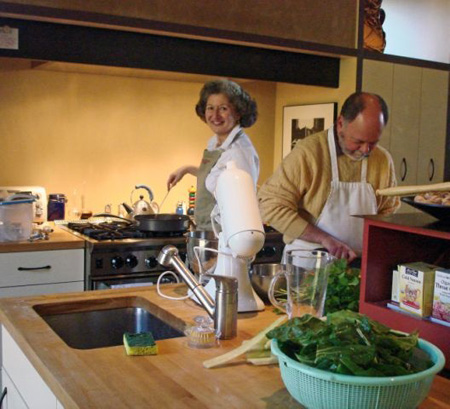
A couple of months ago, I wrote about Lena’s kibbeh and I gave a recipe for the kibbeh itself, and just described how Lena made the stuffing — Lena does not give out recipes, not because she is not willing to share (she is extremely generous) but because she doesn’t believe in them. Then, a reader posted a comment asking for the onion and meat filling which I had mentioned. I was about to post it as an addition, then I thought that instead of posting it alone, I would do a full post on kibbeh bil-saniyeh which I have been making often recently — it’s been my dinner party mainstay for the last few months.
There are a hundred and one way of preparing kibbeh. Possibly more. I could write a whole book about kibbeh alone. How to make it into balls and either grill or fry these or cook them in yoghurt, or in a sauce made with tahini and seville orange juice, or in sumac juice, or cook them with quince in fresh pomegranate juice. Or how to shape the kibbe into disks which are then filled with spiced tailfat or with labneh (strained yoghurt) and coriander. Or how to make kibbeh into a pie (bil-saniyeh) as in the recipe I give at the end of this post. In fact, I could give many more examples of how to shape and prepare this highly seasoned mixture of minced lamb (and don’t let anyone convince you that it is nicer with beef or veal), burghul and onion. But I won’t. I will just show you how to make kibbeh bil-saniyeh.
The pictures here were all shot by Aglaia Kremezi, while I was cooking a Lebanese dinner at a friends’s house in Napa. Also cooking with me were Janet and Doug Fletcher who you see in the photos.
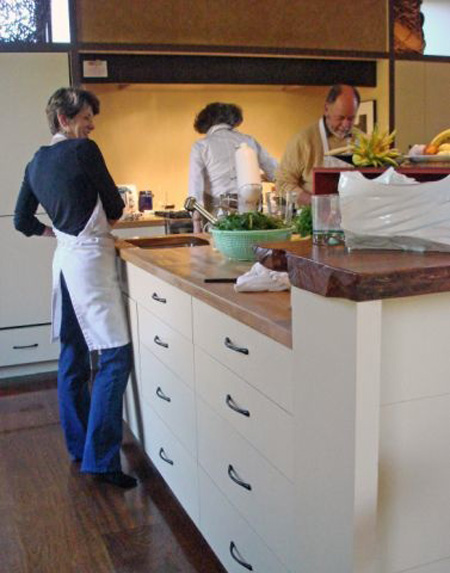
Janet and Doug took care of the shopping too, and more importantly, they took care of grinding the meat for the kibbeh, very fine and very lean for the kibbeh itself and slightly coarser for the stuffing.
So, we got to work. I was in charge of making the kibbeh, Janet of making the pumpkin dip which I had learned from my friend Reem Kelani, the wonderful Palestinian singer (you can read about my cooking with her here and see a lovely picture of the dip) while Aglaia was in charge of making the Swiss Chard fatayer, helped by the “Pastry Princess”, Lissa Doumani — we were at her father’s (Carl) wonderful house where he lives with lovely Pam Hunter.
I started by making the stuffing, then mixed the kibbeh, then set about making the pie, trying to spread the kibbeh as thinly as possible, something I learned from my mother and grandmother while Lissa and Carl make it thicker in their family. We couldn’t find a round baking dish which is the traditional shape so we settled on the rectangular dish below. I spread the bottom layer, covered it with the stuffing and then set about covering the stuffing with another layer of kibbeh. The top layer is a little trickier, it being laid over the textured stuffing.
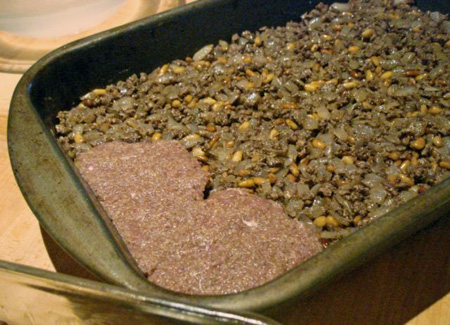
It is always best to start in one corner and to slightly overlap the layers of kibbeh so that you don’t have cracks at the end. And you need to make sure you have even layers of both kibbeh and stuffing.
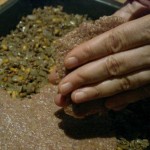 .
.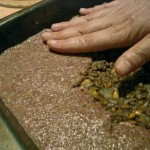
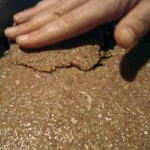
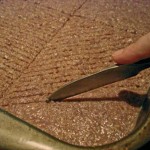
You also need to wet your hands in a little salted water every now and then to make it easier to work the meat mixture. You can see how thinly the kibbeh needs to be in the first picture. And once you finish making the pie, you need to decorate it. My decoration is rather intricate, with each quarter cut in a different, rather tight pattern while Lissa’s and Carl’s family decorate the pie with lozenges all over. Not bad but not as pretty as my handiwork, if I may say so myself. And once the kibbeh is out of the oven, it is a good idea to let it rest for a few minutes before cutting it so that it doesn’t fall apart.
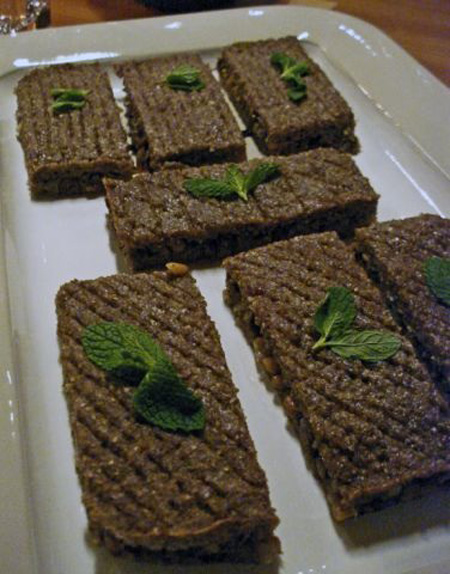
Kibbeh bil-Saniyeh
My London butcher is used now to my eccentric request for a leg of lamb, which he has to bone, skin, defat and, the ultimate crime, put through a fine mincer. If there are other customers waiting, I have to first apologize for monopolising the butcher’s time, then I feel compelled to explain that the meat is not being misused but on the contrary prepared for one of our most renowned national dishes. Serves 4 to 6
for the stuffing
60 g (2 oz) unsalted butter
60 g (2 oz) pine nuts
500 g (1 lb 1 oz) large onions, finely chopped
200 g (7 oz) lean minced lamb 2 teaspoons ground cinnamon
2 teaspoons ground allspice
1/2 teaspoon finely ground black pepper
sea salt
for the kibbeh
1 medium onion, peeled and quartered
500 g (1 lb 1 oz) lamb from the leg, boned, skinned and defatted
200 g (7 oz) fine burghul
2 teaspoons ground cinnamon
2 teaspoons ground allspice
1/2 teaspoon finely ground black pepper
small bowl of lightly salted water
Spread the pine nuts on a non-stick baking sheet and toast in a hot oven for 5 minutes, or until golden brown.
Fry the chopped onion in the butter, until soft and transparent. Add the minced meat and cook – mashing and stirring it with a wooden spoon or fork to separate the meat and stop it from forming lumps – until it loses all traces of pink. Take off the heat, season with cinnamon, allspice, pepper and salt to taste. Stir in the pine nuts. Taste and adjust the seasoning if necessary.
Put the lamb through a fine mincer. You can mince the meat in a blender but you have to be careful not to process it too much. If you do, it will become too smooth and not only lose texture but also be more difficult to shape, especially when you are making kibbeh balls. Before you mince the meat in a blender, cut off and discard as many white chewy ligaments as you can – the blender’s blade will not break these as well as that of the mincer – then drag a serrated knife through the minced meat to catch the last bits of ligament. Wipe the ligaments off the blade and drag the knife through the meat a few more times until you stop picking up sizeable pieces of ligament.
Put the quartered onion in a blender and process until very finely chopped. Add the minced meat, cinnamon, allspice, pepper and salt to taste and blend together until smooth. If your blender is not big enough to take the onion and meat in one go, process them in two equal batches. Prepare a bowl of lightly salted water and have it at hand before putting the meat in a mixing bowl.
Wash the burghul in two or three changes of cold water, drain well and add to the meat. Mix together with your hand, dipping your hand every now and then in the salted water to moisten both your hand and the kibbeh, also adding a little water to the kibbeh to soften it. Knead until you have a smooth mixture, about 3 minutes. Taste and adjust the seasoning if necessary.
Grease a deep baking dish about 30 x 20 cm and 5 cm deep (12 inch x 8 inch and 2 inch deep) with a knob of butter and preheat the oven to 200º C/400º F.
Divide the kibbeh into two equal parts. Moisten your hands in the salted water and pinch off a handful of kibbeh from one piece. Flatten it between your palms, to a thickness of about 1 cm (1/2 inch) and place it on the bottom of the baking dish starting from one edge. Smooth it down evenly with your fingers. Pinch off another handful from the same piece, flatten and lay next to the first piece, slightly overlapping it. Dip your fingers in water and smooth the pieces together until the joint disappears – make sure you connect the kibbeh pieces well together so that they do not come apart during cooking. Continue the above process until you have finished the first half of kibbeh and covered the bottom of the pan. Then go over the whole layer with moistened fingers to even it out.
Spread the stuffing evenly over the layer of kibbeh and lay the other half of kibbeh over the stuffing in the same way as above. You might find the top layer slightly more difficult to do as you will be laying the kibbeh over the loose stuffing instead of the smooth surface of the baking dish but you will soon get the hang of it.
Cut the pie into quarters, then with a knife make shallow incisions to draw a geometric pattern across the top of each quarter (see photos). The decoration work is time consuming and can be omitted without affecting the taste, although the presentation will lose its attractive traditional look. After you finish decorating the pie make a hole in the middle with your finger, put a knob of butter over the hole and one over each quarter. Insert a round pointed knife between the edge of the pie and the side of the pan and slide it all along the pie to detach the meat from the sides.
©anissa helou from Lebanese Cuisine
